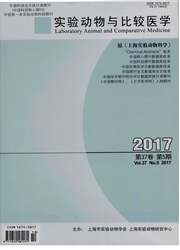

 中文摘要:
中文摘要:
目的 比较两种大鼠脊髓半切模型制作方法的各自特点及其应用,为临床脊髓损伤研究提供适宜的动物模型.方法 60只SD大鼠随机分为脊髓半横切组(A组,n=20)、脊髓楔型块状半切组(B组,n=20)和正常对照组(C组,n=20).术后采用BBB动功能评分、斜板实验、HE染色和MRI检测综合评价两种脊髓半切模型的稳定性.结果 术后A组和B组大鼠伤侧后肢BBB运动功能评分及斜板维持最大角度值显著低于C组(P<0.05),而这些指标在A组和B组之间没有明显差异;术后28dHE和MRI检测示A组和B组间脊髓损伤区组织结构具有显著差异.结论 脊髓半横切与脊髓楔型半切法均可建立稳定、可靠的脊髓半切伤模型,而脊髓楔型半切模型更适于评价移植物治疗脊髓损伤的研究.
 英文摘要:
英文摘要:
Objective Comparing the characteristics and application of two methods for establishing the hemi-sected spinal cord injury model of rats and provide suitable spinal cord injury models for clinical research. Methods Sixty Sprague-Dawley rats were randomly divided into transverse-hemisected group (A group, n=20), wedge-shaped-block-hemisected group (B group, n=20) and normal control group (C group, n=20). After operation, the stability of the two hemi-sected models were comprehensive assessed by Basso-Beattie-Bresnahan (BBB) scores, inclined plane method, HE staining and MRI detection. Results After operation, the BBB scores and maximum angle of inclined Plane method of rats in group A and group B were significantly lower than group C (P〈0.05), but these indexes had no significant difference between group A and group B; In addition, HE staining and MRI detection show a significant morphological change between group A and group B 28 days after operation. Conclusion Both meth- ods of transverse-hemise~ ted and wedge-shaped block-hemisected can establish a stable and reli- able spinal cord injury model, and wedge-shaped-block-hemisected model is more suitable to assess graft treatment of spinal cord injury.
 同期刊论文项目
同期刊论文项目
 同项目期刊论文
同项目期刊论文
 期刊信息
期刊信息
